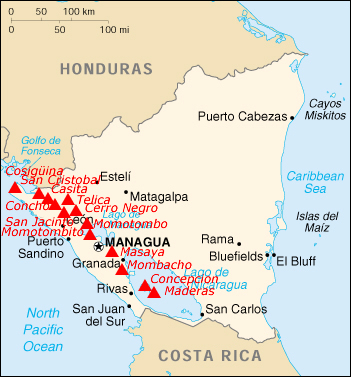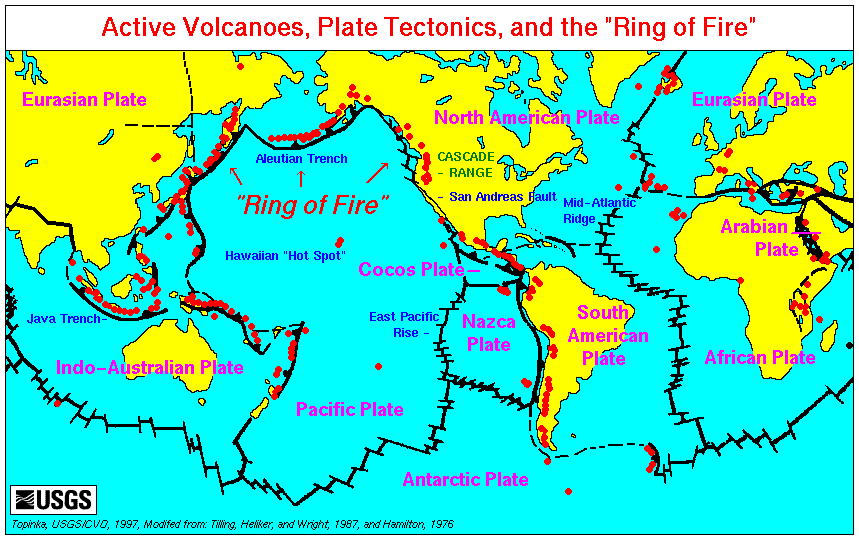|
Las Pilas
Las Pilas (or El Hoyo) is a complex volcano located in the western part of Nicaragua. Part of a 30-km-long volcanic massif, Las Pilas has a series of well-preserved flank vents surrounding a central cone. Las Pilas last erupted in the 1950s and before that possibly in the 16th century. An aerial image of the volcano appeared in the August 1944 issue of National Geographic Magazine (p. 180). On the slope near the peak, a curious circular 100-m diameter sinkhole visible in the 1944 photo is still present in 2020. See also * List of volcanoes in Nicaragua This is a list of active and extinct volcanoes in Nicaragua. Volcanoes See also * Central America Volcanic Arc * List of volcanoes in Costa Rica * List of volcanoes in El Salvador * List of volcanoes in Guatemala * List of volcanoes i ... References Mountains of Nicaragua Volcanoes of Nicaragua Active volcanoes León Department North American 1000 m summits {{Nicaragua-geo-stub ... [...More Info...] [...Related Items...] OR: [Wikipedia] [Google] [Baidu] |
León Department
León () is a department in Nicaragua Nicaragua, officially the Republic of Nicaragua, is the geographically largest Sovereign state, country in Central America, comprising . With a population of 7,142,529 as of 2024, it is the third-most populous country in Central America aft .... It covers an area of 5,138 km2 and has a population of 423,012 (2021 estimate). The capital is the city of León. Municipalities # Achuapa # El Jicaral # El Sauce # La Paz Centro # Larreynaga # León # Nagarote # Quezalguaque # Santa Rosa del Peñón # Telica References Departments of Nicaragua {{Nicaragua-geo-stub ... [...More Info...] [...Related Items...] OR: [Wikipedia] [Google] [Baidu] |
Nicaragua
Nicaragua, officially the Republic of Nicaragua, is the geographically largest Sovereign state, country in Central America, comprising . With a population of 7,142,529 as of 2024, it is the third-most populous country in Central America after Guatemala and Honduras. Nicaragua is bordered by Honduras to the north, the Caribbean Sea to the east, Costa Rica to the south, and the Pacific Ocean and shares maritime borders with El Salvador to the west and Colombia to the east. The country's largest city and national capital is Managua, the List of largest cities in Central America#Largest cities proper, fourth-largest city in Central America, with a population of 1,055,247 as of 2020. Nicaragua is known as "the breadbasket of Central America" due to having the most fertile soil and arable land in all of Central America. Nicaragua's multiethnic population includes people of mestizo, indigenous, European, and African heritage. The country's most spoken language is Spanish language, ... [...More Info...] [...Related Items...] OR: [Wikipedia] [Google] [Baidu] |
Complex Volcano
A complex volcano, also called a compound volcano or a volcanic complex, is a mixed landform consisting of related volcanic centers and their associated lava flows and pyroclastic rock. They may form due to changes in eruptive habit or in the location of the principal vent area on a particular volcano. Stratovolcanoes can also form a large caldera that gets filled in by a lava dome, or else multiple small cinder cones, lava domes and craters may develop on the caldera's rim. Although a comparatively unusual type of volcano, they are widespread in the world and in geologic history. Metamorphosed ash flow tuffs are widespread in the Precambrian rocks of northern New Mexico, which indicates that caldera complexes have been important for much of Earth's history. Yellowstone National Park is on three partly covered caldera complexes. The Long Valley Caldera in eastern California is also a complex volcano; the San Juan Mountains in southwestern Colorado are formed on a group ... [...More Info...] [...Related Items...] OR: [Wikipedia] [Google] [Baidu] |
Massif
A massif () is a principal mountain mass, such as a compact portion of a mountain range, containing one or more summits (e.g. France's Massif Central). In mountaineering literature, ''massif'' is frequently used to denote the main mass of an individual mountain. As a purely scientific term in geology, however, a "massif" is separately and more specifically defined as a section of a planet's crust (geology), crust that is demarcated by geologic fault, faults or lithospheric flexure, flexures. In the plate tectonics, movement of the crust, a massif tends to retain its internal structure while being displaced as a whole. A massif is a smaller structural unit than a tectonic plate and is considered the fourth-largest driving force in geomorphology. The word "massif" originates from French (in which the word also means "massive"), where it is used to refer to a large mountain mass or compact group of connected mountains forming an independent portion of a range. The Cydonia (regi ... [...More Info...] [...Related Items...] OR: [Wikipedia] [Google] [Baidu] |
List Of Volcanoes In Nicaragua
This is a list of active and extinct volcanoes in Nicaragua. Volcanoes See also * Central America Volcanic Arc * List of volcanoes in Costa Rica * List of volcanoes in El Salvador * List of volcanoes in Guatemala * List of volcanoes in Honduras * List of volcanoes in Panama References {{Central American volcanoes Lists of volcanoes, Nicaragua Volcanoes of Nicaragua, Lists of landforms of Nicaragua, Volcanoes ... [...More Info...] [...Related Items...] OR: [Wikipedia] [Google] [Baidu] |
Mountains Of Nicaragua
A mountain is an elevated portion of the Earth's crust, generally with steep sides that show significant exposed bedrock. Although definitions vary, a mountain may differ from a plateau in having a limited summit area, and is usually higher than a hill, typically rising at least above the surrounding land. A few mountains are isolated summits, but most occur in mountain ranges. Mountains are formed through tectonic forces, erosion, or volcanism, which act on time scales of up to tens of millions of years. Once mountain building ceases, mountains are slowly leveled through the action of weathering, through slumping and other forms of mass wasting, as well as through erosion by rivers and glaciers. High elevations on mountains produce colder climates than at sea level at similar latitude. These colder climates strongly affect the ecosystems of mountains: different elevations have different plants and animals. Because of the less hospitable terrain and climate, mountains t ... [...More Info...] [...Related Items...] OR: [Wikipedia] [Google] [Baidu] |
Volcanoes Of Nicaragua ...
This is a list of active and extinct volcanoes in Nicaragua. Volcanoes See also * Central America Volcanic Arc * List of volcanoes in Costa Rica * List of volcanoes in El Salvador * List of volcanoes in Guatemala * List of volcanoes in Honduras * List of volcanoes in Panama References {{Central American volcanoes Nicaragua Volcanoes A volcano is commonly defined as a vent or fissure in the crust of a planetary-mass object, such as Earth, that allows hot lava, volcanic ash, and gases to escape from a magma chamber below the surface. On Earth, volcanoes are most often fo ... [...More Info...] [...Related Items...] OR: [Wikipedia] [Google] [Baidu] |
Active Volcanoes
An active volcano is a volcano that is currently erupting, or has the potential to erupt in the future. Conventionally it is applied to any that have erupted during the Holocene (the current geologic epoch that began approximately 11,700 years ago). A volcano that is not currently erupting but could erupt in the future is known as a dormant volcano. Volcanoes that will not erupt again are known as extinct volcanoes. Overview There are 1,350 potentially active volcanoes around the world, 500 of which have erupted in historical time. Many active volcanoes are located along the Pacific Rim, also known as the Pacific Ring of Fire. An estimated 500 million people live near active volcanoes. ''Historical time'' (or recorded history) is another timeframe for ''active''. The span of recorded history differs from region to region. In China and the Mediterranean, it reaches back nearly 3,000 years, but in the Pacific Northwest of the United States and Canada, it reaches back less tha ... [...More Info...] [...Related Items...] OR: [Wikipedia] [Google] [Baidu] |



